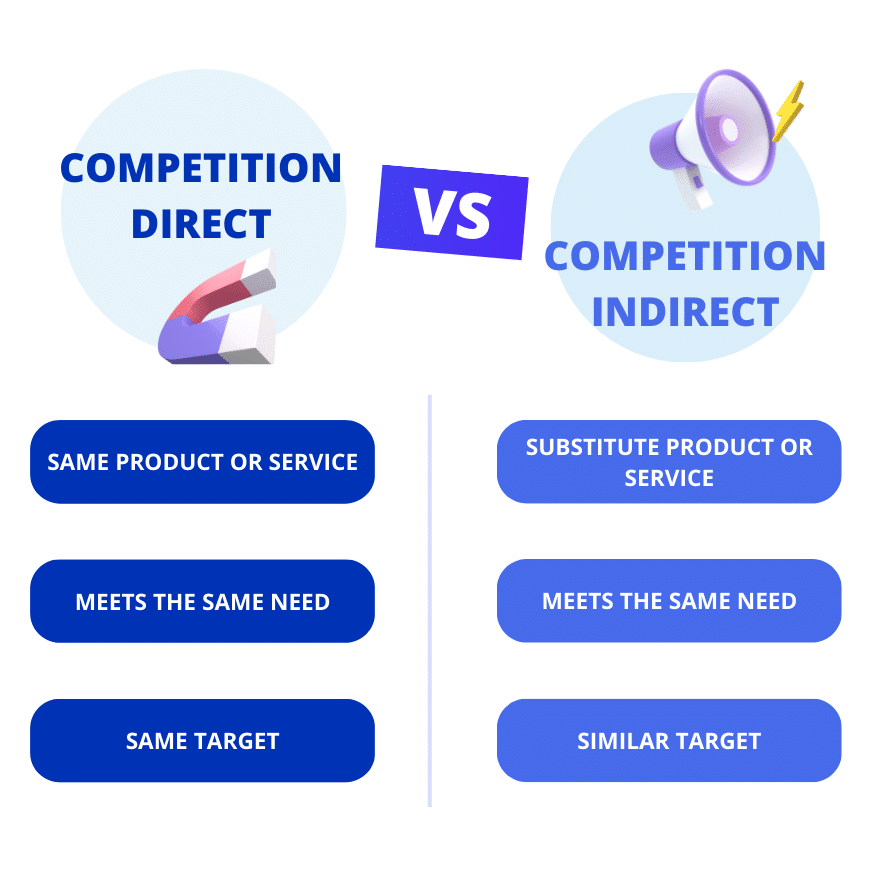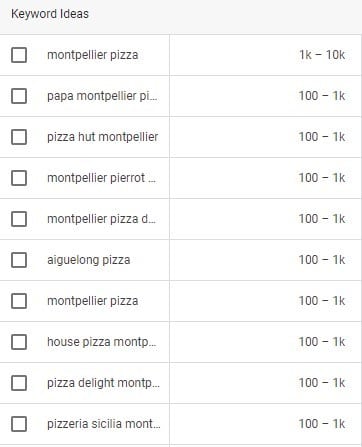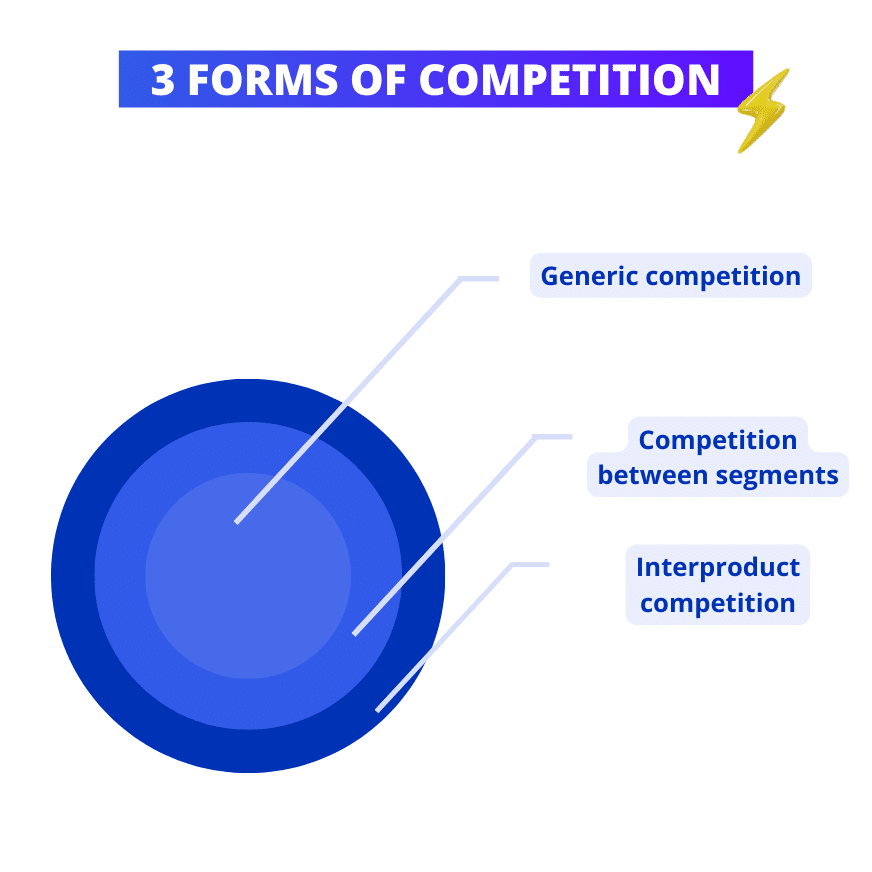Do you have a business but don’t really know how to find or even analyze direct vs indirect competition ? 🤔 This article is for you. More seriously, here we will talk about:
- The definition and an example of direct competition.
- The definition + an example of an indirect competitor.
- Why identify them?
- How to find them?
- How to analyze your competitors?
- And finally, 3 examples to understand.
Are you ready to take on your competitors? We are too, so let’s get going! ⛵️
But first of all, if you’d like a quick summary of the definition as well as why and how to identify them, we’ve got a video on the subject just for you!
Direct competitor: the definition
Let’s get to the heart of the matter. ✨
Direct competitor : example
If you did not understand, here is an example to enlighten you further on the subject. 🕯️
You are a company selling high-tech products online. Your direct competition will be :
- Other online sales sites offering the same products.
- The big brands of the mass distribution.
These competitors will offer attractive prices, promotions and above all, a quality user experience, in order to attract the same customers as you. 🧲
You will therefore need to be able to offer a competitive offer in order to stand out from all these competitors.
Indirect competition def
This time, let’s move on to indirect competition. ⚡
These businesses are not direct competitors, but they can still affect your business by attracting some of your customers. ✨
Indirect competitor example
Here we go again with the example, we know you love it. You are a fine dining restaurant in a fairly touristy town. Here are your indirect competitors:
- 🍔 Fast food restaurants.
- 🏬 Delicatessens.
- 🧑🏼🍳 Caterers.
- 🍷 Wine bars.
- 🚚 The food-trucks.
- 🍴 Brasseries.
In fact, these establishments can attract a portion of your clientele who are looking for a quick and less expensive way to eat. 🥡
You will therefore have to identify your indirect competition and thus, develop a marketing strategy in order to differentiate yourself and meet your customers’ expectations, for example by proposing offers, a unique culinary experience or even click and collect.
Direct and indirect competition: why identify them?
Understand that identifying direct and indirect competition is essential for a company to develop a marketing strategy. But why would you tell me? 🤔 Well, if you don’t know your direct vs indirect competition, you may miss out on development opportunities or even get crushed by more aggressive competition. 🐯 
To illustrate our point, here’s an example: 👇🏼
You are a restaurant and you don’t even know that a food-truck offers burgers to die for a few meters from your home, you could then lose a large part of your clientele.
As you can see, by identifying them, you can adjust your marketing strategy, refine your positioning and even find new customer segments.
How do you find your direct vs indirect competition?
When you run a business, it is essential to know your direct vs indirect competition. Well yes because, knowing who your direct and indirect competitors are is crucial to developing an effective marketing and sales strategy. 📈
That’s why here are 3 tips for finding your direct vs indirect competition. ⬇️
1) Use social networks
Social media is an important source of information about your competitors. Indeed, when you perform a search on social networks such as LinkedIn, Instagram, Twittter or Facebook, you can find companies that offer similar products or services to yours! In this case, don’t hesitate to follow them. 👍🏼
Okay, put your ego aside, we’re going to explain why it’s important to subscribe to your competitors.
➡️ Here’s the reason: you’ll be able to get information about their marketing and sales strategy! 👀
2) Conduct an online search
The easiest and most effective tip is to use search engines like Google to look for companies that offer similar products or services to yours. For example, I’m a pizzeria 🍕 in Montpelier, so I’ll do the following search. 👇🏼 
3) Analyze keywords
Keyword analysis can also help you identify your competitors, using tools such as Google Keyword Planner. You will be able to find keywords related to your business sector and see which companies are ranked for these keywords in the search results. Here is an example with our pizzeria in Montpellier. 📍
I indicate my keyword “pizzeria Montpellier” with Montpellier as the area.

I launch the analysis and here is what is displayed, the keywords associated with this search with my competitors.

How to analyze your competitors?
By examining some of your competitors’ data, you will be able to identify the strengths and weaknesses of each company and understand how you can differentiate yourself in the market. To do this, here is a table that you can copy and paste and use over and over again! ♾️
| Analysis criteria | Direct competitor A | Direct competitor B | Indirect competitor C | Indirect Competitor D |
|---|---|---|---|---|
| Products/Services | ||||
| Price | ||||
| Positioning | ||||
| Marketing strategy | ||||
| Target audience | ||||
| Distribution channels | ||||
| Market share |
In this competitive intelligence table, you can list the relevant analysis criteria for your industry and fill in the columns for each competitive study you have identified. 🔎 Regarding the criteria, they can include items such as:
- 🛍️ The products or services offered.
- 💰 The price.
- 📍 The market positioning of your main competitors.
- 💭 The marketing strategy.
- 🎯 The target audience.
- 👀 The distribution channels.
- 🍰 The market share and competitive advantage.
There are also other marketing tools to perform your competitive analysis such as SWOT (strengths and weaknesses), business plan, market research, benchmark, Porter, mapping, niche market), so feel free to use them! 🥰
Direct vs indirect competition: 3 examples to understand
Now that you know how to find and identify your direct and indirect competitor, here are 3 examples of companies that I think you know, very well. 👀
Direct and indirect competition catering
If I tell you “I’m lovin’ it” or “Come as you are”, do you tell me? 🥁 McDonald’s! This global fast food chain developed by Ray Kroc in 1952 finds itself surrounded by many competitors. In fact, here are the two types of competition: 👇🏼
- The direct competition is made up of other fast food chains with competitive offers, such as Burger King, KFC or Subway. These companies have the same target audience and use the same distribution channels, such as online ordering, drive-throughs and deliveries. 🛵
- Indirect competition can include restaurants with different menus, but that cater to the same customer needs, such as pizzerias, coffee chains, or even family restaurants. These businesses can attract customers who are looking for alternatives to burgers and fries, but are looking for quick and convenient meals. 🍟

So McDonald’s has to find tricks to stay competitive, such as differentiation in its menu, creating attractive promotions, optimizing distribution channels and creating a unique customer experience! 🥰
Direct and indirect competitor apple
Here we will talk about the very famous apple 🍏, American multinational company. Here is a quick summary of these direct and indirect competitors: 👇🏼
- The direct competition consists of other large technology companies that offer competing products, such as Samsung, Google, Microsoft or Amazon. These companies offer phones, tablets, laptops and intelligent voice assistants and these products are quite similar in terms of features, design and performance. 🏋🏼
- Indirect competition can include companies that offer different products that meet the same customer needs, such as camera manufacturers, streaming music channels or software companies.

Direct and indirect competitors of sephora
Let’s finish this series of examples with the French chain of stores selling perfumes and cosmetics, I named Sephora! 💄 
Let’s discover together these competitors: 👇🏼
- The direct competition includes other beauty and cosmetics chains offering competing products, such as MAC Cosmetics, Lush, Marionnaud or Kiko Milano. They have the same target audience and use the same distribution channels, such as physical stores and e-commerce sites. 🌐
- Indirect competition mainly involves drugstores, department stores and natural product stores, as these companies can attract customers who are looking for alternatives to conventional beauty products who are still looking to take care of their skin and appearance. 🪞
How about a quick recap?
As you will have understood, competition plays a crucial role in the success of a company because it allows the company to develop an effective strategy to differentiate itself on the market and thus increase its market share. 🍰
Understand that competition should not be seen as a threat, but rather as an opportunity for growth. 👀
So start by conducting market research, a competitive analysis including the competitive environment, new entrants, catchment area, competitive advantages, competitor shares, competitive offerings and finally, competitive positioning.
Yes, by studying the competition, you will be able to learn from them, and use this knowledge to improve your products, your services and most importantly, the customer experience. Ultimately, healthy competition can benefit all market players. ✨
What are the 3 forms of competition?
In marketing, we distinguish three types of competition, here they are:
- The direct competition (cross-product) ➡️ company that offers products of the same nature.
- Indirect competition (generic) ➡️ company which proposes products of substitution but which have the same target.
- Potential competition (intersegments)➡️ company that does not offer the same products but that operates in the same market.

What are direct competitors?
A direct competitor may use similar or different distribution channels to reach their customers. This can include companies that are in the same geographic or online market. 🖥️
What are the indirect competitors of Carrefour?
There is no need to introduce you to Carrefour, the big supermarket chain. Nevertheless, it has some competitors, here they are:
- DIY stores: Leroy Merlin or Castorama also offer a range of products similar to those of Carrefour (gardening tools, cleaning supplies, household items…)
- Pharmacies: they can offer health products or cosmetics.
- Discount stores: Lidl or Aldi offer similar products at lower prices.
- Online sites: Amazon also offers similar products and above all, offers easy purchase and delivery.
Yes, this will be the last sentence of this article about the direct vs indirect competition but, don’t be sad, we’ll see you soon! 🥰












